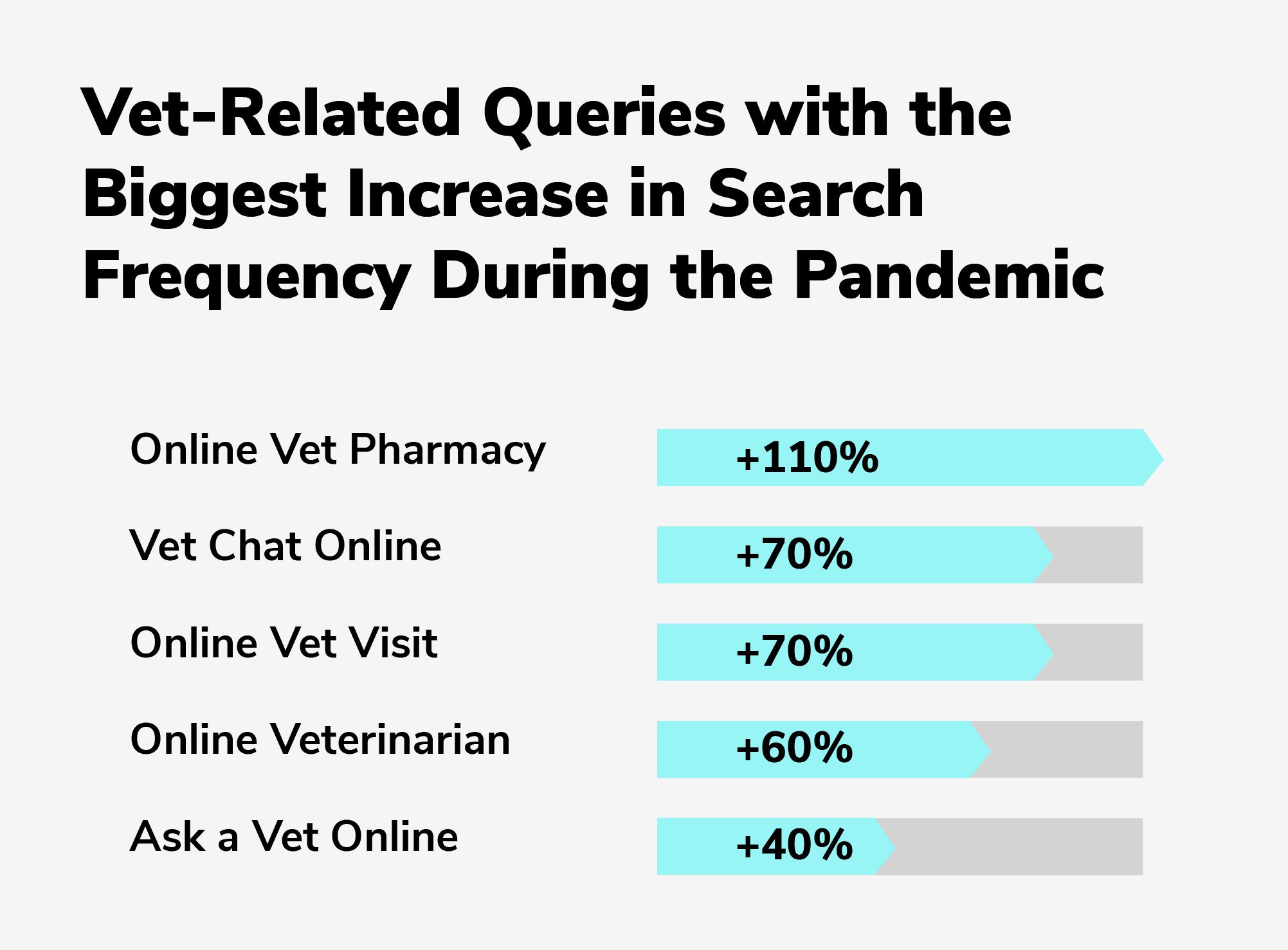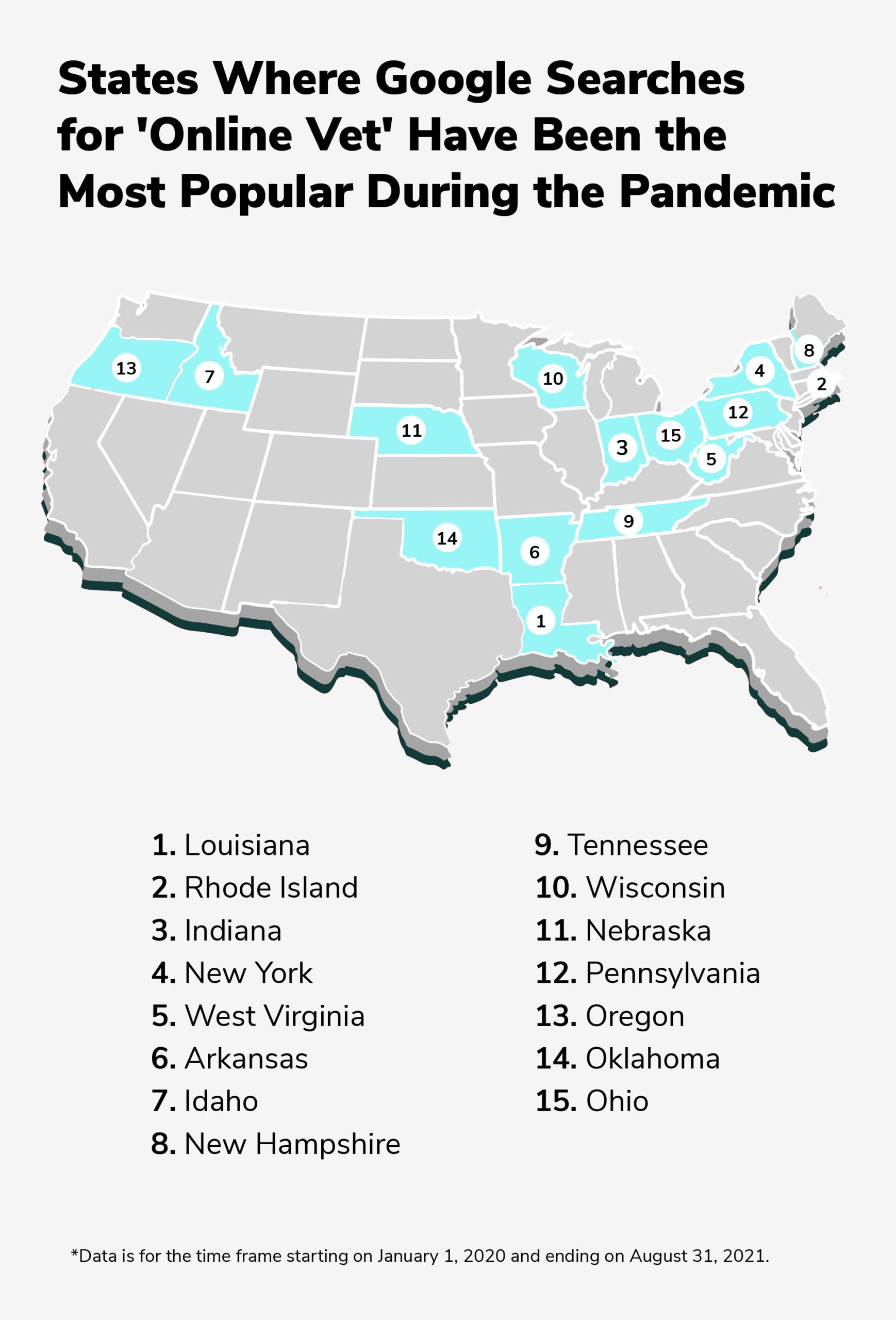Online Vet: The Rise of Telehealth During COVID-19…Even for Pets

Table of Contents

It’s no secret that the COVID-19 pandemic has caused a phenomenal surge in telehealth usage. A recent analysis reported back in July 2021 that telehealth usage increased by 38 times what it had been pre-pandemic. In a time when social distancing mandates are still in place, variants are still emerging, and many prefer to minimize their outings, telehealth options have provided a much-needed bridge between patients and doctors.
But there are other benefits to telehealth as well. According to the CDC, “Telehealth could have multiple benefits during the pandemic by expanding access to care, reducing disease exposure for staff and patients, preserving scarce supplies of personal protective equipment, and reducing patient demand on facilities.”
And telehealth isn’t just about general wellness check-up’s either. Online therapy has skyrocketed in popularity during the pandemic, as has the use of mobile health devices. Another form of telehealth that’s emerging front-and-center? The online vet.
The Special Reports Team at Onevet.ai dug deeper into this phenomena and took a look at the rise of online vets, the best veterinary telehealth platforms out there, and the states where Google searches for an online vet are the most popular.
.
What is an Online Vet?
When it comes to an online vet, what you see is what you get. An online vet is just that: a health practitioner with a DVM (Doctorate in Veterinary Medicine) who provides outpatient services over the internet. Given the substantial costs of the average bill at the veterinary clinic, veterinary telehealth has emerged as a viable option for many budget-mindful pet owners across the U.S.
However, the COVID-19 pandemic in particular has made veterinary telehealth more popular than ever as pet owners seek to social distance without compromising on reliable and trustworthy healthcare for their pets. This trend may be an especially common practice among vulnerable populations such as older adults. According to the University of Michigan’s National Poll on Healthy Aging, 55% of people aged 50 to 80 are pet owners, but with 95% of COVID-related deaths occurring in those over the age of 45, an online vet may be the solution for staying safe while still keeping a pet healthy.
Online Vet Searches on the Rise
Google searches for ‘online vet’ have peaked several times since January 2020, doubling in number from January to February, and then increasing by another 24% in April. The highest peak yet came in August 2021, when searches for online vets were higher than ever across a period of 20 months.
Other related search terms that have seen a substantial increase in search frequency during the pandemic include online vet pharmacy (up by 110% since before January 2020), vet chat online (+70%), and online vet visit (+70%), among others.

A quick search on Google for the best online vets will return a plethora of results. Some of the best online vets and veterinary telemedicine platforms available today include OneVet, FirstVet, PetCoach, Vetster, AskVet, and more. Each platform offers a unique array of services including on-demand consultations, vaccination trackers, online prescription services, and in the case of OneVet, a $3,000 emergency fund that covers pre-existing conditions regardless of a pet’s age.
Where Are Searches for Online Vets Most Popular?

The Special Reports Team at Onevet.ai conducted a state-by-state Google Trends analysis to determine where in the U.S. Google searches for ‘online vet’ have been the most popular during the pandemic.
It turns out Louisiana leads the pack with the highest proportion of Google searches for online vet, followed by Rhode Island, Indiana, New York, and West Virginia. Three of these states (Louisiana, Rhode Island, and West Virginia) have some of the lowest employment levels for veterinarians, which may explain the prevalence of searches in these areas. These ‘vet deserts’ result in poor access to veterinary care, leading pet owners to seek health professionals who practice online. Of the remaining ten states on our Top 15 list (pictured below), nearly half also suffer from low employment levels for veterinarians (Arkansas, Idaho, New Hampshire, Nebraska).
What about states where employment levels for veterinarians are the highest, such as in the case of New York, Pennsylvania, and Ohio? In these instances, it may be the number of COVID-19 cases driving pet owners to opt for virtual vet appointments. New York is the #4 state with the highest reported number of coronavirus cases in the U.S., with a total number of over 2.3 million. Pennsylvania, Ohio, and Tennessee also appear in the Top 10, with over 1.3 million, another 1.3 million, and 1.1 million cases respectively. An additional four states (Indiana, Wisconsin, Louisiana, and Oklahoma) have each reported over half a million coronavirus cases. In light of such significant numbers, it’s understandable that pet owners feel more comfortable consulting with an online vet over waiting in the lobby at their local animal clinic to speak with a veterinarian face-to-face.
In other cases, it may be a state’s large population of older adults that are contributing to the rising search for online vets. Three of the states in our Top 15 list boast a significant population of adults aged 65 and up: 17% of New Hampshire and Pennsylvania’s population consists of this demographic, while it makes up 18% of West Virginia’s population. For an additional five states (Arkansas, Ohio, Rhode Island, Wisconsin, and Oregon), 16% of the population is made up of adults over the age of 65. Considering 95% of COVID-related deaths occur in those over the age of 45, senior pet owners in these states may be exploring telehealth options for their companion animals as a means of staying safe.
Online Vet: Final Thoughts
If recent trends are any indication, the growing popularity of telehealth will only continue to increase. The good news is that this rise in telehealth can potentially reduce the spread of COVID-19 and other diseases while helping to minimize patient demand on clinics and hospitals and the staff that populate such facilities. Fortunately, thanks to new innovations within the tech worlds, telehealth isn’t just for human patients anymore. Online vets are emerging to help provide quality care for companion animals while allowing pet owners to still practice social distancing in the midst of the pandemic. For states where there is little access to veterinary care, where COVID-19 cases are astronomical, or where a large number of pet owners are adults over the age of 65 (who are more vulnerable to the coronavirus), this evolution in veterinary medicine will no doubt make all the difference in the world, both for animals and the people who love them.















